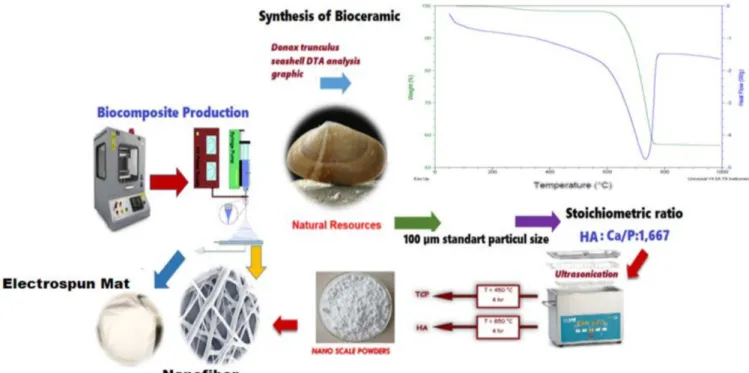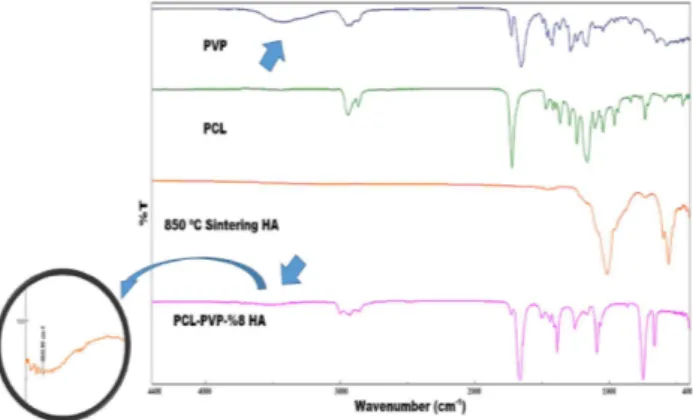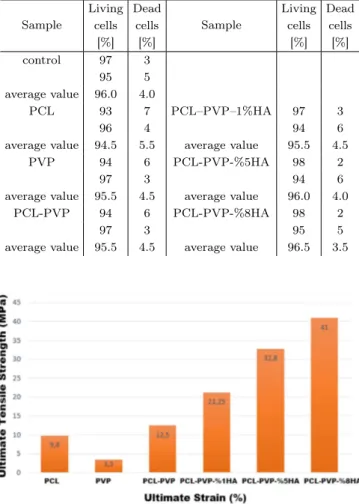Vol. 135 (2019) ACTA PHYSICA POLONICA A No. 5
Special Issue of the 8th International Advances in Applied Physics and Materials Science Congress (APMAS 2018)
Natural Nanohydroxyapatite Synthesis via Ultrasonication
from
Donax Trunculus Bivalve Sea Shells
and Production of its Electrospun Nanobiocomposite
Y.M. Sahin
a,b,∗aIstanbul Arel University, ArelPOTKAM (Polymer Technologies and Composite Application and Research Center),
Buyukcekmece, 34349, Istanbul, Turkey
bIstanbul Arel University Department of Biomedical Engineering, 34349, Istanbul, Turkey
In the present study, hydroxyapatite (HA) and tricalcium phosphate (TCP) bioceramics were prepared via a practical, ultrasonic conversion method from Donax trunculus seashells. These seashells are one of the most com-mon bivalve molluscs of the Mediterranean Sea and can be used as a natural, stable raw material for bioceramic production. Ultrasonication, a powerful method for nano-sized ceramic production, was chosen to synthesize differ-ent ceramic phases easily. Raw shells are consisted of calcite and aragonite structures. To synthesize HA and TCP bioceramic materials, first the calcium oxide content of the shells were identified via Differential Thermal Analysis (DTA) and then a calculated amount of phosphoric acid was added drop by drop to obtain the exact stoichiometry. After synthesis, the resultant bioceramics were sintered at 800–850◦C for HA and 400–450◦C for TCP phases. For bioceramic phases X-ray Diffraction (XRD), Fourier Transform Infrared Spectrometer (FTIR), Field Emission Gun Scanning Electron Microscope (FEGSEM) studies were perform. On the other hand, electrospinning method was used to prepare nanobiocomposites from biocompatible polymeric material as the matrix and the obtained natural bioceramics as reinforcer of the composite system. Three different compositions were used and optimum electrospinning conditions were adjusted to prepare these electrospun structures. Biocomposites were evaluated in terms of structure, mechanic, morphology and biology. The effect of bioceramic content was also discussed. It is revealed that the obtained electrospun nanobiocomposites are good candidates for various tissue engineering purposes due to their enhanced biological and mechanical properties.
DOI:10.12693/APhysPolA.135.1093
PACS/topics: marine sourced bioceramics; ultrasonic conversion; electrospun biocomposites; tissue engineering
1. Introduction
Biocomposites have recently been the focus of much research to enhance biological and mechanical properties of the biomaterial. An encouraging challenge will be to built up nanofiber structures that enhance survival and uniform distribution of cells resulting superior properties. These systems should be stiff enough to ease handling, while elastic enough to limit damage to newly occured tissues [1]. Thus a composite material incoorporated bio-ceramic and polymeric phases are presented purposefully in this study. In view of the variety of roles played by bio-ceramics in different tissues, researches have focused on developing novel biomaterials to mimic the bone struc-ture. Bone is a composite structure composed of HA crys-talls that dipersed througout an biocompatible polymeric matrics [2]. In the proposed study, in order to mimic bone structure, beside a bioceramic (HA) biocompatible polycaprolactone (PCL) and polyvinylpyrrolidon (PVP) were chosen to prepare electrospun composites of PCL– PVP–HA, for tissue engineering purposes.
HA chemical and crystal structure just resemble to those of bone and tooth minerals, HA is indispensable biomaterial for bone grafting in orthopedics as a filling
∗e-mail: ymugesahin@arel.edu.tr
material [2]. HA can either obtained from commercially or synthesized from bones (i.e. human, animal, fish) as allograph materials. In clinical practice, fresh allo-grafts are rarely used due to the immune response and risk of transmission of diseases. Thus the latter, synthe-sized HAs are need calcination to get rid of these risks. So, herein as an alternative source of bioceramic, ma-rine shells, were utilized. The synthesis method of this HA, ultrasonication, are effortless and less energetic in comparison to the other methods in the literature such as microwave and hydrothermal methods that need com-plicated and expensive systems [2] Having biphasic bio-ceramic formations, these HAs synthesized from natural sources enhance biocompatibility and bioresorbtion [3]
In the proposed study, natural bioceramics were syn-thesized via ultrasonication method to give mechanical strength and enhanced biological properties to the pro-duced composite whereas, biocompatible and degradable polymers were chosen as the polymeric matrix.
2. Materials and equipment
For bioceramic synthesis, Donax trunculus shells were obtained from a gift store and Ortho-phosphoric acid (85%, reagent purity) were purchased from Merck. Util-lized chemicals DMF, chloroform and polymers, PCL and PVP having molecular weights 80,000 g/mole and 360,000 g/mole, were purchased from Sigma-Aldrich and used as they received.
1094 Y.M. Sahin Donax trunculus shells were cleaned, grinded and sieved under the obtained powder 100 µm (Fig. 1). The calcium oxide content of the of the sea shells was de-termined by thermogravimetric analysis (TGA). Subse-quently, shell powder added to 50 ml of distilled wa-ter and titrated with orthophosphoric acid at 80◦C to adjust the Ca/P mole ratio as 1.67 for HA pro-duction. After filtration and drying, powders were sintered at 850◦C, to convert into final bioceramic phases.
PCL dissolved in a solvent mixture of chloroform/DMF (60:40) and PVP in DMF in an ultrasonic bath. Three different concentrations (1%, 5% and 8%) of HA were added to the obtained PCL-PVP solution and homoj-enized at 45◦C for 1 h in an ultrasonic bath. Subse-quently, the prepared solution was purged to the electro-spinning system to obtain the electrospun mats. Struc-tural (XRD, FTIR), morphological (FEGSEM), biologi-cal (in-vitro tests) and mechanibiologi-cal (tensile testing) char-acterizations were conducted for these nanobiomaterials.
Fig. 1. Bioceramic synthesis and nanobiocomposite mat production processes.
3. Results and discussion
3.1 Structural characteriazations of bioceramic and biocomposites
In the light of XRD analysis of bioceramic powders, biphasic structures, 97.3% HA and 2.7% α-TCP, were ob-tained (Fig. 2.). Among the most important properties of HA, its perfect biocompatibility can be pronounced. HA chemically bonds to hard tissue and within 4–8 weeks newly formed osteoblast cells accumulates. The osteo-conductive properties of HA also allow the implants to firmly adhere to the bone [3]. In addition α-TCP can dis-solve and gradually degrade in the body. It also supports the formation of new bone by releasing calcium and phos-phate ions [4]. The FTIR spectrum of the nanofiber mats were shown in Fig. 3. The bands observed in frequency range of 2945–2866 cm−1 are due to CH2 stretching for
PVP and PCL. At 1164 cm−1, 1239 cm−1and 1294 cm−1 symmetrical C–O–C stretching bands were observed for the main polymeric matris, PCL of the composite. The intense peak at 1721 cm−1 is the characteristic car-bonyl (C=O) stretching band of PCL component [5].
Fig. 2. XRD patterns of the sample sintered at 850◦C. On the other hand, carbonyl stretching of PVP was observed at 1682 cm−1. Moreover the broad band at 3420 cm−1 is indicative of O–H stretching for PVP.
Natural Nanohydroxyapatite Synthesis via Ultrasonication from Donax Trunculus Bivalve Sea Shells. . . 1095
Fig. 3. FTIR spectra of HA, PVP, PCL and nanofiber mats.
The PO−34 groups of HA gave absorption bands between 1000–1100 cm−1. The additional bands observed at a fre-quency range of 650–750 cm−1comes from HPO−24 group of HA. The CO−23 group of HA on the other hand, showed a weak peak at a frequency of 872 cm−1and strong bands between 1430–1530 cm−1 [2]. For PCL–PVP-8%HA bio-composite, functional group bands overlaped and were
in agreement with the polymeric composition. More-over, different from the polymeric content the obeserved HPO−24 stretching bands between 650–750 cm−1were in-dicative of HA content in the composite.
3.2 Morphology and size analysis of bioceramic and biocomposites
Morphology of the samples were examined by FEGSEM, and different allotropic structures were de-termined for the synthesized bioceramic powder (Fig-ure 4a and 4b). For electrospun mats (Fig. 4c–h.), nanofiber structures were observed and their mean diam-eters were calculated by using Image J (2011) software. Average particle diameter of the synthesized bioceramic was 153 nm whereas, the mean diameters of the fibers for electrospun mats were in the range of 40-220 nm. As HA concentration increases, bioceramic powders coat the polymer fibers homogeneously, resulting in a stronger and finer nanofiber structures [5]. The synthesized natu-ral HA powders in this study, distributes homogeneously on the fibers. The finest fiber diameter were obtained in the PCL/PVP/8%HA composite (Fig. 4h).
Fig. 4. Microstructure of bioceramic at (a) ×800 (b) ×3000 and nanofiber mats at ×6000 (c) PCL, (d) PVP, (e) PCL-PVP, (f) PCL-PVP-1%HA, (g) PCL-PVP-5%HA, (h) PCL-PVP-8%HA.
1096 Y.M. Sahin
3.3. Cell viability and mechanical of bioceramic and biocomposites
Table I summarizes the in vitro tests of the nanobiocomposites. For all nanocomposite mats, live cells, attached to the surface and stained with DAPI (40,6-diamidino-2-phenylindole) were reported. Cell vi-ability of the electrospun mats were found above 94%. By increasing the bioceramic content cell viability per-centages were enhanced. As it is revealed below the best cell viability value was observed for the composites con-taining 8% of HA.
TABLE I Cell viability values of biocomposites.
Sample Living cells [%] Dead cells [%] Sample Living cells [%] Dead cells [%] control 97 3 95 5 average value 96.0 4.0 PCL 93 7 PCL–PVP–1%HA 97 3 96 4 94 6
average value 94.5 5.5 average value 95.5 4.5 PVP 94 6 PCL-PVP-%5HA 98 2
97 3 94 6
average value 95.5 4.5 average value 96.0 4.0 PCL-PVP 94 6 PCL-PVP-%8HA 98 2
97 3 95 5
average value 95.5 4.5 average value 96.5 3.5
Fig. 5. Tensile test results of nanobiocomposites.
Mechanical properties of the electrospun nanofiber were identified according to ASTM E4 standards and given in Fig. 5. The highest ultimate tensile strength value was obtained as 41.0 MPa. Being consistent with morphological investigations, mechanical properties of the composites enhanced as HA content increased. Dif-ferent electrospun nanobiocomposites are presented in the literature, whereas, the mechanical results obtained in the present work are one of the highest tensile strength among all [5].
4. Conclusion
Nanosized natural HA powders were synthesized by ultrasonication method and characterized. In order to overcome the weak mechanical properties of the poly-meric matris, a biocompatible ceramic additive was uti-lized as reinforcer and the mechanical properties of the nanobiocomposites were improved. Since the synthe-sized natural HA bioceramic powders coated the poly-mer fibers homogeneously, reinforcing effect was observed and thinner nanofiber mats were obtained. As a conse-quence, cell adhesion to the scaffold surface was increased and the mechanical properties were improved. Ascend-ing the amount of HA in PCL–PVP nanofiber compos-ite materials, biocompatibility and mechanical strength of biomaterials have been found to increased. The finest fibers were acquired for the PCL–PVP–8%HA composite. These nanocomposites, which are produced by using nan-otechnology from natural hydroxyapatites, can be ideal materials for tissue engineering due to their biological and mechanical superiority.
Acknowledgments
I would like to thank to Polymer Technologies and Composite Application and Research Center (ArelPOTKAM) for material characterizations.
References
[1] F. Anjum, N.A. Agabalyan, H.D. Sparks, N.L. Rosin, M.S. Kallos, J. Biernaskie,Sci. Rep. 7, 10291 (2017). [2] O. Gunduz, Y.M. Sahin, S. Agathopoulos, B. Ben-Nissan, F.N. Oktar,J. Nanomater. 1, 382861 (2014). [3] J. Enax, E. Matthias,Oral Health Prev. Dent. 16, 7
(2018).
[4] J.L. Dávila, M.S. Freitas, P.I. Neto, Z.C. Silveira, J.V.L. Silva, M.A. d’Ávila,J. Appl. Polym. Sci. 133, 43031 (2016).
[5] Y.J. Lee, A. Elosegui-Artola, K.H.T. Le, G.M. Kim,


